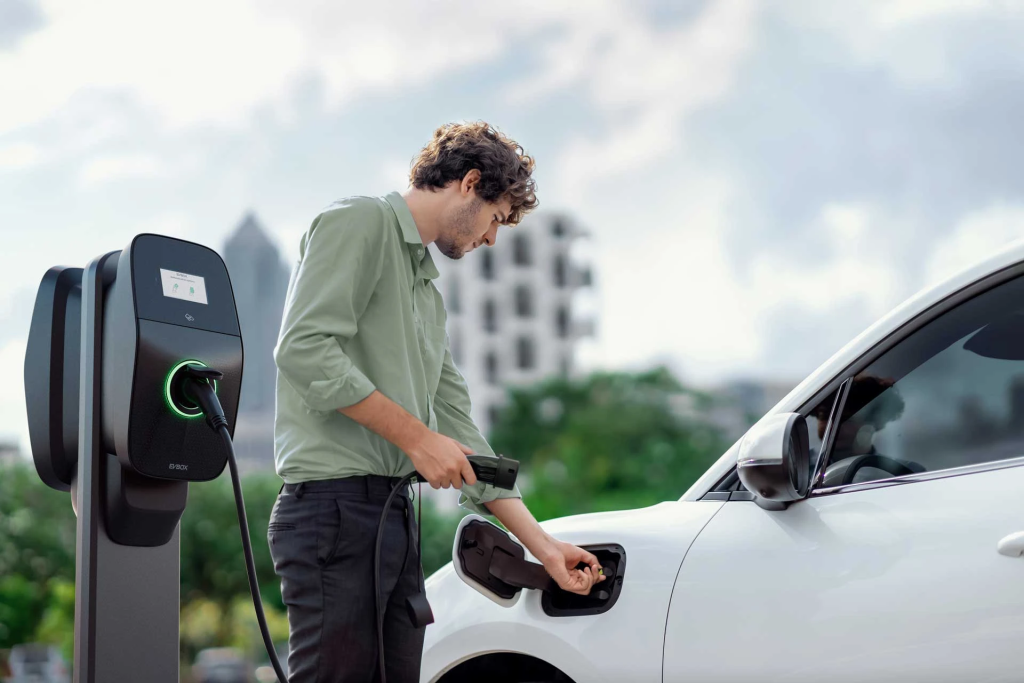
Products
Fast, Reliable, Everywhere

Solutions
Efficient, Innovative EV Charging Solutions.
News
We are committed to the innovation and application of EV charging.

Electric vehicles (EVs) require charging to keep their batteries powered, and this can be done in two ways: through AC (Alternating Current) charging or DC (Direct Current) charging. Both methods have their advantages and drawbacks, but the most noticeable difference between them is the charging speed. As EV adoption grows, the need for faster charging solutions is more critical, especially for commercial uses. However, it’s not just about speed—charging health, which refers to how the charging method affects long-term battery performance, is equally important. This article will explore the key differences between AC and DC charging and explain why DC charging is significantly faster than AC.
Alternating Current (AC) charging is the more common form of charging, often used in homes and public slow chargers. AC power is what’s delivered to your house from the power grid. When it comes to charging an EV, this AC power is first delivered to the vehicle’s onboard charger, which converts the AC into Direct Current (DC). Only then can the DC power be stored in the EV’s battery. The onboard converter plays a critical role in this process but also limits the amount of power that can be transferred, which is why AC charging tends to be slower.
One of the key benefits of AC charging is its wide availability. Most homes, workplaces, and public locations offer AC charging stations, which are less expensive to install than DC fast chargers. Additionally, AC charging is generally easier on your battery, meaning it may contribute to better long-term battery health. The slower charging speed allows the battery to charge more evenly and safely, which helps preserve its longevity.
However, the limitation of AC charging is that it takes significantly longer to charge an EV, especially for commercial vehicles with larger batteries. For example, using a standard 7kW AC charger, it can take over eight hours to fully charge an EV with a 60kWh battery, whereas a DC charger can accomplish this in under two hours. This significant time difference is one reason why commercial fleet operators and EV infrastructure planners often prefer DC chargers.
Direct Current (DC) charging is a faster method that bypasses the vehicle’s onboard AC converter. Instead, the charging station itself converts AC to DC before delivering it directly to the EV battery. By doing this, DC chargers can provide much higher power levels—often ranging from 50kW to as high as 350kW, depending on the charger’s specifications. This allows for much faster charging times, making DC chargers the preferred option for commercial uses, such as in public fast-charging stations or along highways where drivers need a quick charge to continue their journey.

The primary benefit of DC charging is speed. Since DC power is fed directly into the battery without the need for onboard conversion, it significantly reduces the time it takes to charge an EV. For example, a 50kW DC charger can charge an EV to 80% in about 30-40 minutes, and ultra-fast DC chargers with outputs up to 350kW can do it in just 10-15 minutes.
That said, there are some limitations to DC charging. While fast charging is convenient, the frequent use of high-speed DC chargers could lead to increased wear on the battery over time, which could affect its long-term charging health. However, advancements in battery technology, such as improved thermal management and smarter charging algorithms, are helping to mitigate these effects, allowing batteries to handle faster charging more efficiently.
The primary reason why DC charging is faster than AC charging lies in the power conversion process. In AC charging, the power must first be converted from AC to DC by the onboard charger, and this conversion process takes time and limits the amount of power that can be delivered to the battery. Most onboard chargers in EVs are only capable of handling between 7kW and 22kW, which directly impacts the speed at which the battery can be charged.
In contrast, DC charging stations handle the conversion externally and deliver power directly to the battery, bypassing the onboard charger’s limitations. This results in a much faster power transfer process, allowing for higher charging speeds. For example, a 150kW DC charger can provide more than six times the power of a typical home AC charger. It’s important to note, though, that balanced charging routines—using both AC and DC chargers—can help maintain battery longevity and charging efficiency over time.
Another critical factor in why DC charging is faster is the difference in power levels between AC and DC chargers. Most AC chargers deliver between 3.7kW and 22kW of power, suitable for slow or medium-speed charging. On the other hand, DC fast chargers start at 50kW and can go up to 350kW, providing a much higher level of power for rapid charging.
For instance, charging a 60kWh battery with a 22kW AC charger would take approximately 3 hours, while a 150kW DC charger could accomplish the same in just 30 minutes. This speed advantage makes DC chargers ideal for commercial charging stations, where fast turnaround times are essential for keeping fleets or long-distance EV drivers on the road.
In summary, DC charging is faster than AC charging due to its ability to bypass the vehicle’s onboard converter and deliver higher power directly to the battery. While AC chargers are more common and beneficial for home use, their power limitations make them less suitable for rapid charging, especially in commercial applications. On the other hand, DC chargers are the go-to solution for businesses that require fast, efficient charging to minimize downtime and maximize fleet or vehicle utilization.
However, a well-rounded approach that incorporates both AC and DC charging options is recommended for optimal charging health and battery longevity. The future of EV charging will likely involve continued innovation, making both AC and DC technologies more efficient and accessible.
